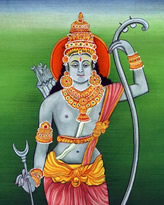 |
Sri
Rama |
Fans of the television series set in the mythic Star Trek universe know how heroic figures can act as models for behaviour, and how these stories are returned to again and again for inspiration and ethical guidance. The two great Hindu epics, the Ramayana and the Mahabharata, have exerted a similar power on generations of believers. Rama, whose birthday is celebrated on Ramnavami, is considered to be the seventh incarnation of Lord Vishnu, and the Ramayana tells of his progression (ayana, ‘march’) in search of human values that are worth living by.
The original Ramayana was an epic poem in Sanskrit attributed to the poet Valmiki* and consisting of 24,000 couplets. Oral versions circulated for centuries before it was put into written form around the start of the Common Era. Since then it has been translated into many languages,** and the tales of Rama, his wife Sita, his brother Lakshmana and and his devoted follower Hanuman live on to this day in dance, drama, puppet shows, songs and movies.***
In addition to being the ideal of a good son and husband, Rama is also known for his prosperous and righteous reign, the Ramraja. All of this is celebrated on Ramnavami. A reading of the entire epic may take place during the preceding week, with highlights of the story recounted in the temple on the actual day. A special prayer is performed at midday, the moment when Rama is said to have been born: prasad—specially blessed food—is offered to an image or picture of the baby Rama which has been placed in a cradle, after which the food may be shared among the congregation.
Homes are cleaned and decorated prior to Ramnavami and offerings of fruit and flowers are placed on the family shrine. The youngest female of the household anoints the other family members with a red mark (tilak) before everyone joins together in worship. In many places there is a procession, the main attraction of which is a chariot in which four persons are dressed up as Rama, Lakshmana, Sita and Hanuman (for more about Hanuman see Hanuman Jayanti).
*The
Ramayana bears signs of different layers of composition; however Valmiki
may have been the kusilava (‘bard’) who introduced
the sloka (‘sound,’ ‘song of praise,’
‘praise,’ or ‘stanza’), a verse form consisting
of two lines of 16 syllables each or four half lines of 8 syllables each.
**For instance
the popular Hindi version known as Ram-charit-manas, written
by Goswami Tulsidas in the 16th century CE.
***Other
festivals that remember events from the Ramayana include Dusshera
and Diwali.
The first is held in honour of the siege of Lanka and Rama’s victory
over the demon king Ravana; the second is the great festival of lights,
which commemorates the return of
Rama and Sita to their kingdom
in Ayodhya.